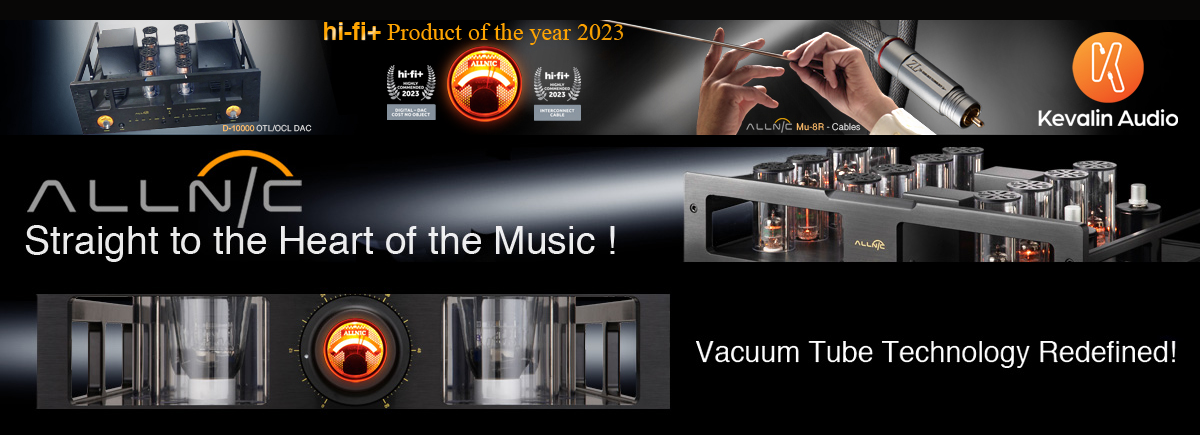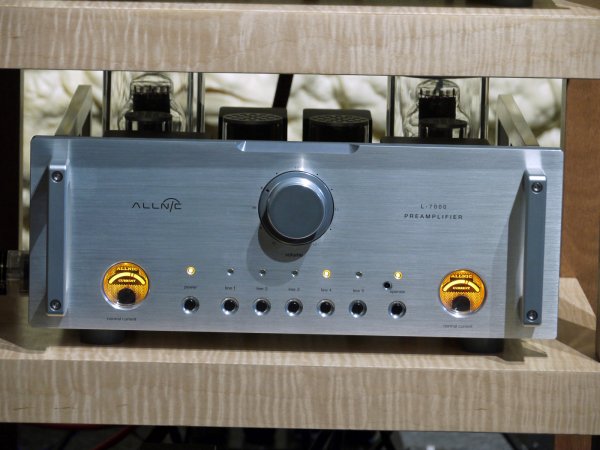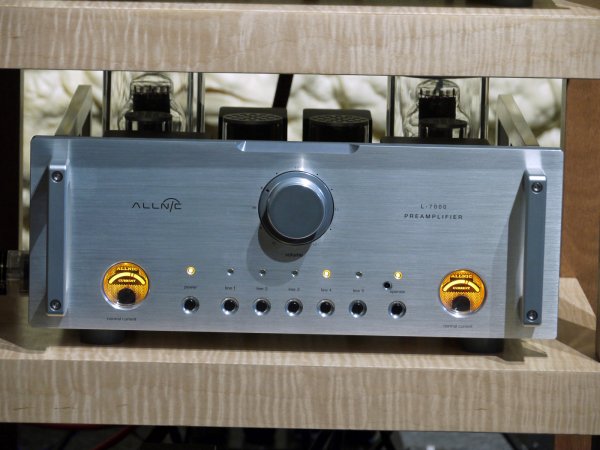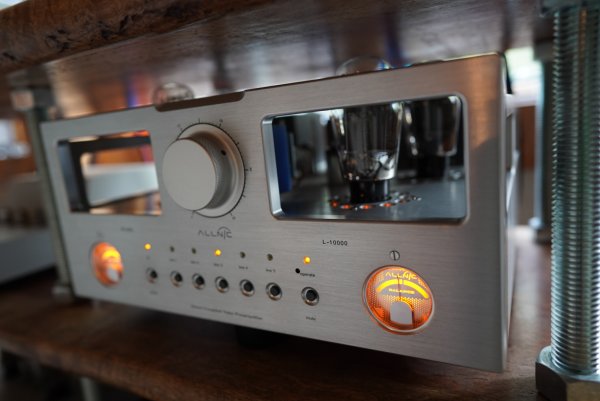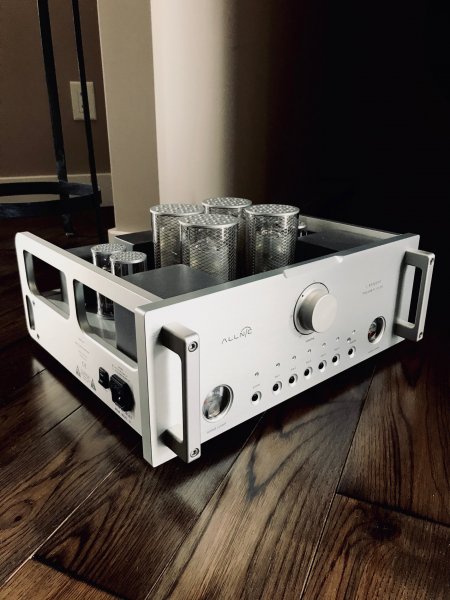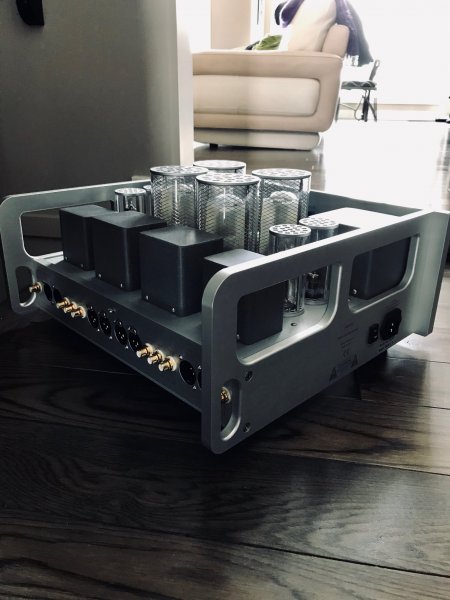Greetings! It has been some time since I have written any review or contributed to any forum. Now I have come across something that is worth an audition in any system. The NEW Allnic L-10,000 OTL/OCL Line-stage. This is my first experience with a transformer-less and capacitor-less component. Having once owned the entire Allnic line-stage product line and now familiar with their new/current line and the significant jump in performance the last couple of years, I feel it is important to give my impression of each and post links to some current reviews. While my impression remains subjective and always evolving, there remains insight. Allnic gear is a significant investment and not one to take lightly. The economics alone makes it somewhat difficult to demonstrate units side by side.
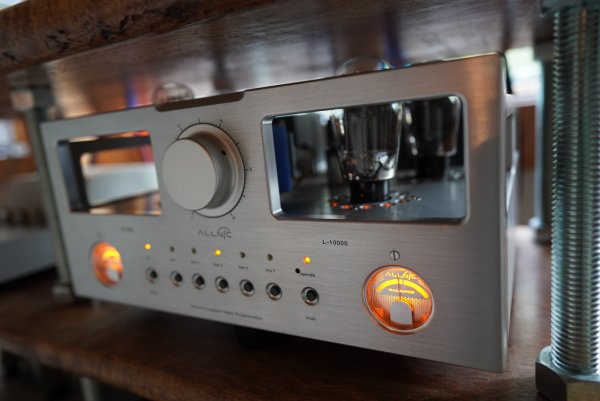
The L-10,000, while not by any means inexpensive, to realize the true potential of the benefits associated with this circuitry I had to reconfigure some aspects of my system.
The Allnic L-10,000 OTL/OCL contains a more complex wiring system than the new Allnic L-8000 DHT, thus involving a circuit board and necessitating a somewhat higher price point. The clarity presented with this line-stage demonstrates how a preamp can really be the limiting (read detrimental) component in the signal pathway. The L-10,000 is a single ended designed circuit, meaning in order to run balanced outputs, there exists a small insulation transformer, which separates the ground from the cold signal. The output from this line-stage is 20V, so even when you need to run long distances - for me 31 feet, a well shielded unbalanced cable performs without issue. This level of potential also has a secondary benefit for low output wattage, single stage class A amplifiers that only boost an already strong and very clean signal. This gives much greater headroom and overall dynamics. Dynamics and clarity are the L-10,000’s strengths.
This preamp also has a low 200 Ohm impedance output and, therefore, plays well with most if not all amplifiers on the market. Using the unbalanced output avoids the introduction of a transformer, boosts performance and creates an ethereal presentation that is otherwise lost on the balanced outputs. I asked Kang Su Park why bother having balanced outputs? Consumer demand.
Trying to eliminate any confounding influences, I inquired with my source component manufacturer, Collin Shin of Waversa Systems. He stated the output stages are of comparable sonic qualities. I then used the same brand and model cable, Antipodes Reference, between my sources and the L-10,000. However, the balanced XLR cable was 3 meter and the unbalanced RCA cable was 1.5 meter. The single-ended input to the line-stage improves sound significantly—much more open, airy, with a deep soundstage. This difference in clarity is not subtle, which demonstrates to me that ideally, to be most synergistic, different pieces of equipment should be of the same circuit topography. In other words, use single-ended circuit design components with single-ended cabling throughout the signal path.
Even with the standard tubes, there is no warm-up required. What the L-10,000 pre-amp offers is bar none the greatest improvement to my system since this journey started in 2012, L-4000, L-3000 mkii to L-5000 DHT to L-10,000. This upgrade tops any dac and other component upgrade. The clarity and presentation are on such a high level that every family member took notice.
Regarding tube influence in the signal path: 12AU7>>300Bb>>>6AN8, the latter had only one manufacturer and supply is plentiful. Another advantage here is 12AU7s are not expensive, with the rarest, most coveted tube costing me $200 --but what a difference with RT 12AU7WA Black Plate. Oh my, super quiet, super refined, soooo delicious. This one does no wrong at all, period. These are pretty much neutral, with a lot of special thrown in: air, density, energy, dimension, and super wet sounding. To me: deep, soulful, sultry, passionate.
I switched from Russian stock tubes to Kron 300Bs and did not observe much improvement. However, I do notice a deeper and tighter bass. Seems for my L-10,000 changing the 300B tubes had limited benefit. I have interest in the anticipated release of Western Electric 300B re-issue but production remains forever delayed. I know in this line-stage David Beetles was not super impressed with Takatsuki TA300B, which is a proven spectacular tube. I speculate this may be more to do with the circuit design of the L-10,000. Because of the wide variation of presentation, the adventure in tube rolling may pay dividends most by investing in the cheaper 12AU7s.
From my personal life story, I can never pinpoint the moment I found love, yet I certainly noticed the moment it ends. Once my system had great emotion but then was lost for many years. This left me somewhat frustrated and disenchanted in the hobby. It was one unexpected day I received a phone call from David Beetles of Hammertone excited about his ‘holy shit’ moment, and unlike finding love, I too shared this moment. Finally, there exists a tonality and subtleties with deep intricate layering presenting great emotion long missed and in reality never experienced to date! With great appreciation of Kang Su and his team at Allnic Audio Labs, I agree this unit is a keeper!
The L-10,000 was the single, best, most unexpected improvement in my system, ever. I would argue that, the same as with gear with transformers, the L-10,000 will age like wine and will continue to evolve for the better. Right out of the box, though, you will grin as I did and be forever grateful.
The L-8000 DHT as stated below has advantages over its predecessor, the L-5000 DHT, in that the overall circuit is dead silent with your ear to the speaker (as is the L-10,000 OTL/OCL). I found the DHT tubes at one time challenging and with some nurturing was able to attain a quiet circuit. The L-5000 DHT was not a unit you pull off your rack, take across town and place in your friend’s system. My kids when younger discovered and enjoyed speaking to the NOS 3A/109B DHT tubes and hearing their voices amplified from the speakers. These days my tubes hear only words of appreciation.
The L-8000 DHT is a point to point wired circuit, robust and without fuss. Like the L-7000, there’s proven reliability. The L-10,000 by its nature presents the recording with unforgiving clarity. If the analog or digital recording is compressed with limited dynamics, the overall presentation is apparent and sometimes perhaps irritating. This is where I give a nod to the L-8000 DHT. All music, regardless of the recording, is somehow forgiven and sounds sublime. With a less forward presentation, increased layering, and overall emotion, this unit may indeed be the sweet spot of the entire product line.
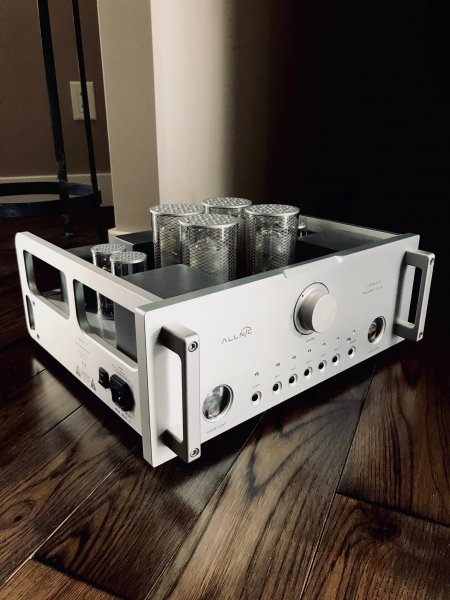

The L-10,000, while not by any means inexpensive, to realize the true potential of the benefits associated with this circuitry I had to reconfigure some aspects of my system.
The Allnic L-10,000 OTL/OCL contains a more complex wiring system than the new Allnic L-8000 DHT, thus involving a circuit board and necessitating a somewhat higher price point. The clarity presented with this line-stage demonstrates how a preamp can really be the limiting (read detrimental) component in the signal pathway. The L-10,000 is a single ended designed circuit, meaning in order to run balanced outputs, there exists a small insulation transformer, which separates the ground from the cold signal. The output from this line-stage is 20V, so even when you need to run long distances - for me 31 feet, a well shielded unbalanced cable performs without issue. This level of potential also has a secondary benefit for low output wattage, single stage class A amplifiers that only boost an already strong and very clean signal. This gives much greater headroom and overall dynamics. Dynamics and clarity are the L-10,000’s strengths.
This preamp also has a low 200 Ohm impedance output and, therefore, plays well with most if not all amplifiers on the market. Using the unbalanced output avoids the introduction of a transformer, boosts performance and creates an ethereal presentation that is otherwise lost on the balanced outputs. I asked Kang Su Park why bother having balanced outputs? Consumer demand.
Trying to eliminate any confounding influences, I inquired with my source component manufacturer, Collin Shin of Waversa Systems. He stated the output stages are of comparable sonic qualities. I then used the same brand and model cable, Antipodes Reference, between my sources and the L-10,000. However, the balanced XLR cable was 3 meter and the unbalanced RCA cable was 1.5 meter. The single-ended input to the line-stage improves sound significantly—much more open, airy, with a deep soundstage. This difference in clarity is not subtle, which demonstrates to me that ideally, to be most synergistic, different pieces of equipment should be of the same circuit topography. In other words, use single-ended circuit design components with single-ended cabling throughout the signal path.
Even with the standard tubes, there is no warm-up required. What the L-10,000 pre-amp offers is bar none the greatest improvement to my system since this journey started in 2012, L-4000, L-3000 mkii to L-5000 DHT to L-10,000. This upgrade tops any dac and other component upgrade. The clarity and presentation are on such a high level that every family member took notice.
Regarding tube influence in the signal path: 12AU7>>300Bb>>>6AN8, the latter had only one manufacturer and supply is plentiful. Another advantage here is 12AU7s are not expensive, with the rarest, most coveted tube costing me $200 --but what a difference with RT 12AU7WA Black Plate. Oh my, super quiet, super refined, soooo delicious. This one does no wrong at all, period. These are pretty much neutral, with a lot of special thrown in: air, density, energy, dimension, and super wet sounding. To me: deep, soulful, sultry, passionate.
I switched from Russian stock tubes to Kron 300Bs and did not observe much improvement. However, I do notice a deeper and tighter bass. Seems for my L-10,000 changing the 300B tubes had limited benefit. I have interest in the anticipated release of Western Electric 300B re-issue but production remains forever delayed. I know in this line-stage David Beetles was not super impressed with Takatsuki TA300B, which is a proven spectacular tube. I speculate this may be more to do with the circuit design of the L-10,000. Because of the wide variation of presentation, the adventure in tube rolling may pay dividends most by investing in the cheaper 12AU7s.
From my personal life story, I can never pinpoint the moment I found love, yet I certainly noticed the moment it ends. Once my system had great emotion but then was lost for many years. This left me somewhat frustrated and disenchanted in the hobby. It was one unexpected day I received a phone call from David Beetles of Hammertone excited about his ‘holy shit’ moment, and unlike finding love, I too shared this moment. Finally, there exists a tonality and subtleties with deep intricate layering presenting great emotion long missed and in reality never experienced to date! With great appreciation of Kang Su and his team at Allnic Audio Labs, I agree this unit is a keeper!
The L-10,000 was the single, best, most unexpected improvement in my system, ever. I would argue that, the same as with gear with transformers, the L-10,000 will age like wine and will continue to evolve for the better. Right out of the box, though, you will grin as I did and be forever grateful.
The L-8000 DHT as stated below has advantages over its predecessor, the L-5000 DHT, in that the overall circuit is dead silent with your ear to the speaker (as is the L-10,000 OTL/OCL). I found the DHT tubes at one time challenging and with some nurturing was able to attain a quiet circuit. The L-5000 DHT was not a unit you pull off your rack, take across town and place in your friend’s system. My kids when younger discovered and enjoyed speaking to the NOS 3A/109B DHT tubes and hearing their voices amplified from the speakers. These days my tubes hear only words of appreciation.
The L-8000 DHT is a point to point wired circuit, robust and without fuss. Like the L-7000, there’s proven reliability. The L-10,000 by its nature presents the recording with unforgiving clarity. If the analog or digital recording is compressed with limited dynamics, the overall presentation is apparent and sometimes perhaps irritating. This is where I give a nod to the L-8000 DHT. All music, regardless of the recording, is somehow forgiven and sounds sublime. With a less forward presentation, increased layering, and overall emotion, this unit may indeed be the sweet spot of the entire product line.



